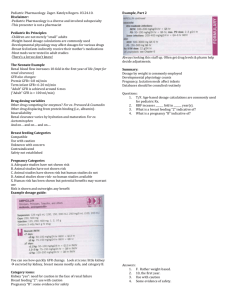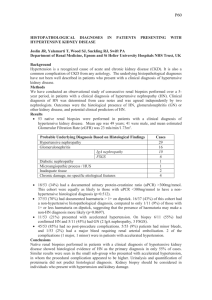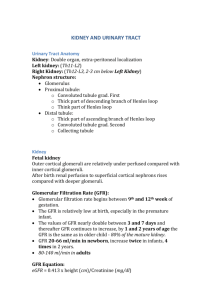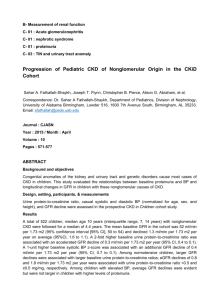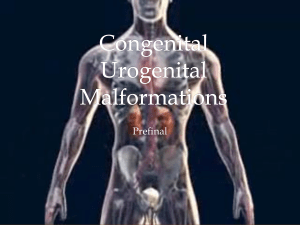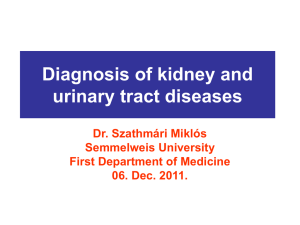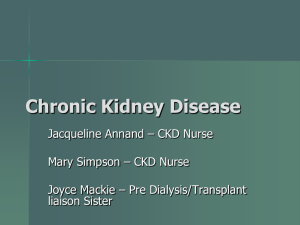diabetic nephropathy & chronic renal failure / chonic kidney disease
advertisement
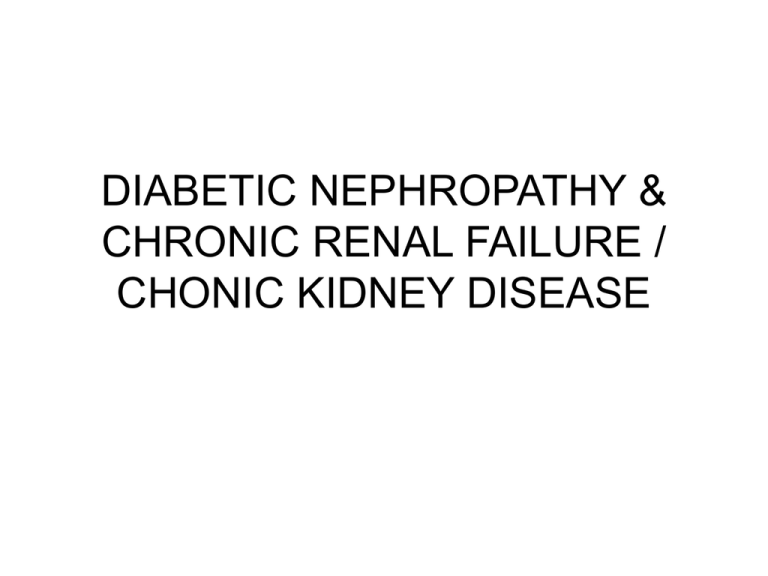
DIABETIC NEPHROPATHY & CHRONIC RENAL FAILURE / CHONIC KIDNEY DISEASE Incipient Nephropathy Predictors? Hyperfiltration Microalbuminuria Rising BP Poor glycemic contol 0 2 5 Onset Of DM Functional changes GFR increase (renal hypertrophy) reversible albuminuria increase kidney size IDDM, 30-40% DN NIDDM, 10-20% DN HTN 11-23 13-25 15-27 Onset of Proteinuria Rising S.Cr ESRD Structural changes increase GBM thickening Mesangial expansion nodular (Kimmelstiel-Wilson) & diffuse forms of intercapillary glomerulosclerosis capsular drop lesion fibrin cap lesion Morphologic changes • Glomeruli: – increase GBM thickening – Mesangial expansion – nodular (Kimmelstiel-Wilson) & diffuse forms of intercapillary glomerulosclerosis – capsular drop lesion – fibrin cap lesion • Tubulointerstitium,& tubular functional defects – – – – – • • Interstitial scarring Impaired tubular reabsorption of low MW proteins and albumin Increased Na reabsorption leading to volume expansion Hypercalciuria Impaired excretion of H & K ions Vascular, hyaline thickening of the arteriolar wall Glomerular haemodynamic changes – Decreasing Pglom: ACE-I, ARB, low protein diet Transient microalbuminuria • • • • • • Hyperglycemia Hypertension Congestive heart failure Urinary tract infection Excessive physical exercise Albumin Excretion Rate / AER – Normal < 30 mg/day – Microalbuminuria 30-300 mg/d – Overt proteinuria AER> 300 mg/d Overt Diabetic Nephropathy • In early DN the albuminuria is secondary to a loss of the anionic charge barrier of the GCW • In established DN, the proteinuria is due to the presence of an increased number of nonselective and large pores • The presence of persistent proteinuria heralds the overt phase of DN • >95% of patients with DN have D Retinopathy • Rate of decline in GFR has been reported as linear in a given patient, but wide differing between patients • ~ 1 ml/min per month, with 50% of patients reaching ESRD ~ 7 years after the onset of proteinuria. • Recent reports suggest that is has slowed down ~10 years Complication of DM • Microvascular – Retinopathy – Nephropathy • Macrovascular – Peripheral vascular disease – Coronary artery disease – Cerebrovascular disease • Diabetic neuropathy, incl. gastroparesis • Hyperkalemic RTA Syndrome ‘X’ • Obesity • Decreased glucose tolerance, Insulin resistance & hyperinsulinemia • Hypertension • Hyperlipidemia, esp triglycerides • Increased risk for atheroscerosis NIDDM • Patients on HD in a dialysis unit ~ 30-50% because of NIDDM & diabetic nephropathy • Many patients with NIDDM will die of other causes (cardiovascular) before reaching ESRD • Natural history less well characterized • Heterogeneous group, with many comorbid conditions, hypertension, obesity • 10-20% incidence of DN, mostly after 10-20 y • Familial predisposition Management • Control of Diabetes, HbA1c <7 • Control of hypertension, BP<130/80, if proteinuria BP<125/75 • Low salt diet • Control of hyperlipidemia • Weight control • Smoking cessation • Management of other comorbid conditions; cardiovascular, anemia, cerebrovascular, physical inactivity... • ACE-I, ARB, combination CHRONIC KIDNEY DISEASE CKD usg CKD • Diabetic Nephropathy • Hypertension • Glomerulonephritis – Acute – Rapidly Progressive GN – Chronic GN – Secondary GN ( Infections, Malignancies, Autoimmune Ds,…) • Drugs & Toxins • Hereditary : Alport’s, PCKD, …. • Congenital : VU Reflux • Obstructive Nephropathy Signs & Symptoms • • • • • • • Edema High Blood Pressure Nocturia Frequency & Dysuria Loin pain unrelated to movements Hematuria Proteinuria CRF & ESRD • • • • • • • • • • • • Poor appetite. Nausea & vomiting Insomnia & Restlessness Labile mood swings Asthenia Shortness of breath. – Pulmonary edema. Metabolic acidosis Cardiac arrhythmias. Hyperkalemia Hypertensive urgencies / emergencies LVH Anemia Malnutrition Hyperphosphatemia Hyperparathyroidism KIDNEY DIDEASE • Prevalent in identifiable groups – Aging , > 50 – DM – Hypertension – Cardiovascular disease, CVD – Family members – Herbal medicine (jamu), Analgetics RISK FACTORS(+)--- CHECK URINE & CR -----MCU NORMAL HEMATURIA/PROTEINURIA START NONSPEC IFIC THERAPY REGULAR CHECKS HIGH CR PREVENTIVE ACTION RENAL US--------CRF/Hydronephrosis ESTIMATE GFR / 24H U CCT SPOT U Prot/Cr RATIO / 24H U Prot IMMUNOLOGY SEROLOGY :C3,C4,ANA,ANCA , a-dsDNA, GBM-Ab ETIOLOGY??? RENAL BIOPSY DIAGNOSIS & PROGNOSIS SPECIFIC THERAPY : STEROID, IMMURAN CYCLOPHOSPHAMIDE, CYCLOSPORIN, MMF/CELLCEPT Therapy CKD • Specific Therapy. depends on etiology & histopathology • Decrease proteinuria / albuminuria • Tightly control Blood Pressure < 125 / 75 – ACE-I, ARB, non-dihydropyridine-CCB,…. • Tightly control Blood Sugar • Manage hyperlipidemia • Stop smoking • Low protein diet 0.6 – 0.8 g /kg BW/day • Manage Anemia and other co morbidities, • Manage Cardiovascular ds, • Complications of decreased kidney function • Preparation for kidney failure and RRT • Initiation of RRT Progression of CKD • Mechanisms of ongoing renal injury – – – – – – – – – Deposition IC, Ag, Ab, matrix, collagen, fibroblasts Intracapillary coagulation Vascular necrosis Hypertension & increased Pglom Metabolic disturbances, e.g. DM, hyperlipidemia Continuous inflammation Nephrocalcinosis ; dystrophic & metastatic Loss of renal mass / nephrons Ischemia; imbalance between renal energy demands and supply • Results in – Glomerulosclerosis – Tubular atrophy – Interstitial fibrosis Compensatory renal changes in CKD • Hypertrophy of residual nephrons • Increased RBF per nephron, but decreased total RBF • Increased Single Nephron GFR / SNGFR – Increased osmotic / solute load – Hyperfiltration – Increased intraglomerular pressure / Pglom ## NEPHRONS Pcap +flow Glomerular injury Protein flux Glomerulosclerosis ## NEPHRONS Glomerular hyperfiltration • Pattern of excretory adaptation – Increased filtered load; Cr, BUN – Decreased tubular reabsorption; Na, H2O – Increased tubular secretion; K+, H+, Cr • Limitation of nephron adaptation – Magnitude – Time, ~response to intake / load, production • Abrupt changes in intake / production may not be tolerated – Trade off, expense to other systems • E.g. to preserve P balance PTH increases Volume Urine, Uosm, U(Na,K,H) • Multiple mechanisms of chronic hypoxia in the kidney. • Mechanisms of hypoxia in the kidney of chronic kidney disease include loss of peritubular capillaries (A), • Decreased oxygen diffusion from peritubular capillaries to tubular and interstitial cells as a result of fibrosis of the kidney (B), • Stagnation of peritubular capillary blood flow induced by sclerosis of "parent" glomeruli (C), • Decreased peritubular capillary blood flow as a result of imbalance of vasoactive substances (D), • Inappropriate energy usage as a result of uncoupling of mitochondrial respiration induced by oxidative stress (E), • Increased metabolic demands of tubular cells (F), and • Decreased oxygen delivery as a result of anemia (G). • Treatment modalities that target chronic hypoxia in the kidney • Improvement of anemia by EPO • Preservation of peritubular capillary blood flow by blockade of the renin-angiotensin system • Protection of the vascular endothelium – VEGF – Dextran sulfate • Antioxidants to improve the efficiency of cellular respiration • HIF-based therapy (hypoxia inducible factor) – Prolyl hydroxylase inhibitors – Gene transfer of constitutively active HIF Intact nephron hypothesis • Using experimental animals; urine from each kidney was collected seperately Before K1 K2 GFR NH3 excr NH3 excr/100mlGFR 50 49 100 50 51 100 After K1 K2 End K2 55 66 120 14 25 121 24 40 167 K2 was partially removed K1 removed Conclusion -Normal renal tissue undergoes hypertrophy to compensate for loss of functioning nephrons -Normal tubules adapt, increase in function as other tubules are lost -Diseased nephrons / tubules adapt in the same way ~ increase NH3 excr / 100mlGFR -Even diseased nephrons can increase their GFR The Uremic Syndrome • Nervous system – – – – • Impaired concentration, perceptual thinking, Peripheral neuropathy; primarily sensory, paresthesias, restless leg syndrome Autonomic neuropathy; impaired baroreceptor function, orthostatic hypotension, impaired sweating Uremic ancephalopathy Hematology system – Anemia is invariably present when renal function fall <30% • • • • • • • – Bleeding diathesis: easy bruising, slow clotting • • • • – Decreased RBC survival, response to EPO, Deficiencies of Fe, B12, folate, aluminium overload Blood loss Hyper PTH Inflammation – malnutrition Bone marrow fibrosis Inadequate dialysis Prolonged BT & abnormal platelet function PF3 concentration are generally low, impaired aggregability Reduced von Willebrand’s factor HMW multimers Uremic toxins & PTH Immune function • • • Impaired Ab response to viral Ag (not to bacterial) Decreased T-cells Cutaneous anergy • Cardiovascular system – Cardiovascular disease is the leading cause of death in patients with CKD stage 4-5 – Accelerated Atherosclerosis / CAD – Hypertension, ~ 80% of all uremic patients – Pericarditis • Metabolic abnormalities – Lipids; increase in tot. triglycerides, Lp(a), LDL, decrease HDL – Carbohydrate metabolism; insulin resistance, decreased need for OAD / insulin in DM – High prolactin; galactorrhea – Men : testosteron is low, FSH / LH normal or high – Women: pg E2 & progesterone are low, FSH /LH normal or slightly elevated – Abnormalities of thyroid gland function test, normal TSH CKD stage 5 (ESRD / GGT) • DIALYSIS / Renal Replacement Therapy – Hemodialysis – Peritoneal Dialysis – Continues Renal Replacement Therapies • Kidney Transplant – Cadaver – Living related / unrelated



